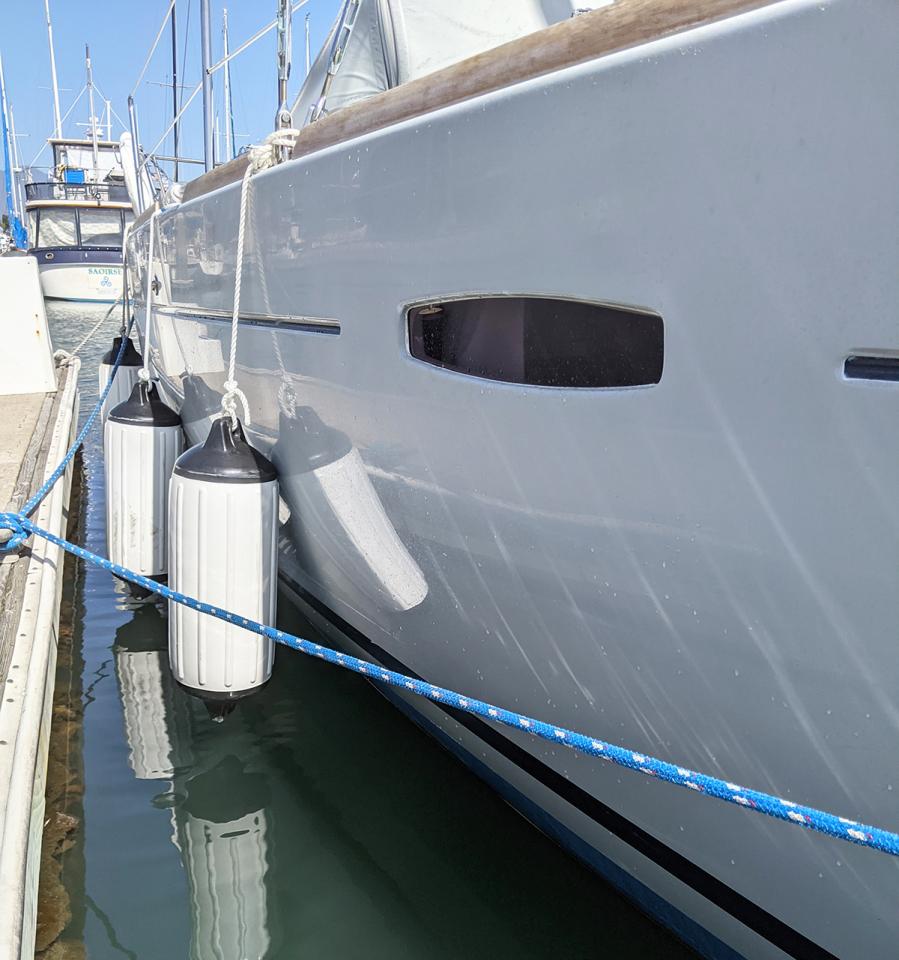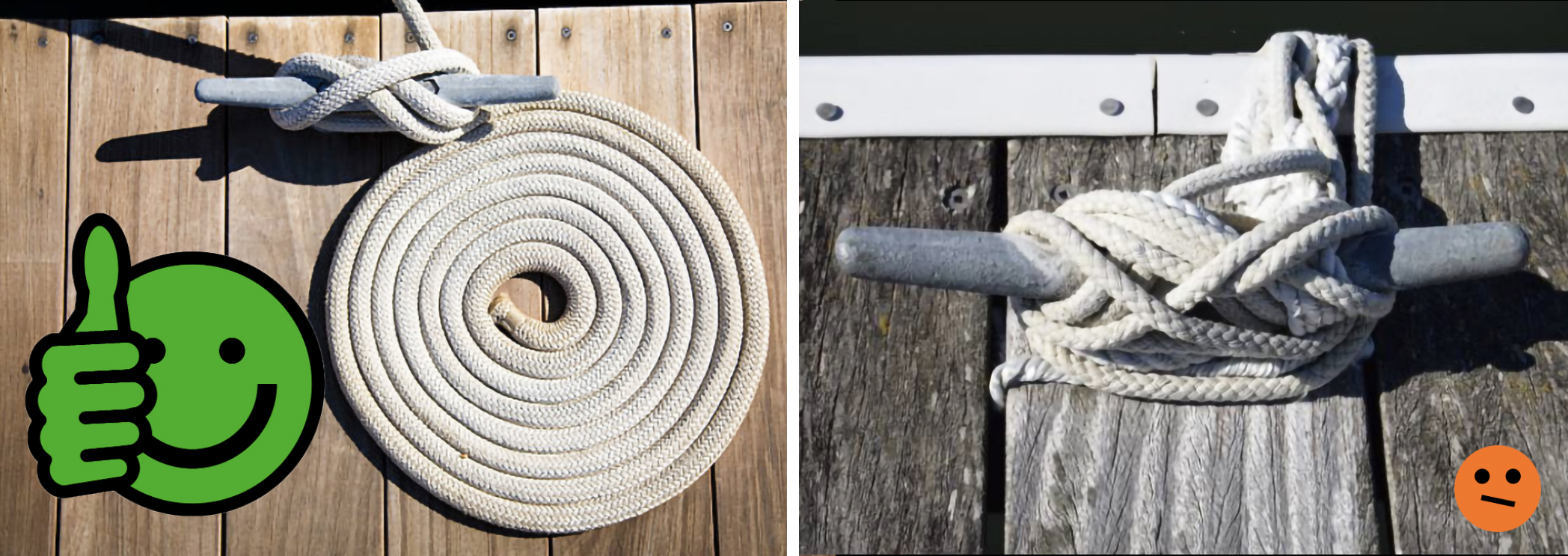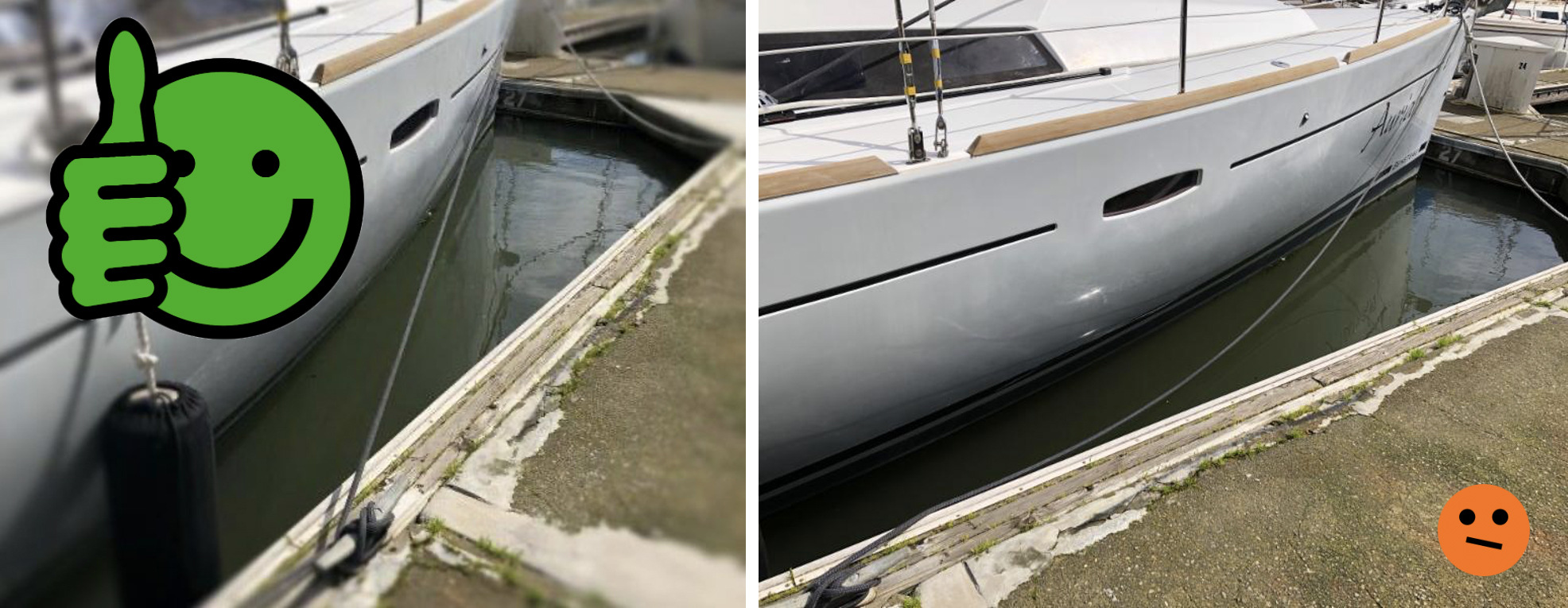
San Francisco Bay's strong winds are a challenge to boats even when they are resting at the dock. Properly tying dock lines and fenders will limit your boat's motion in the slip and help protect her from damage caused by being pushed against the dock by the wind. These skills can be easy to forget if you haven't used them on a regular basis.
With this article, learn (or refresh your memory of) the best ways to keep your boat and the dock from becoming too closely acquainted and leaving a lasting impression on one another.
Cleat Hitches
First, let's look at how to tie a cleat hitch - the best way to tie a dock line to a dock cleat.
Below, the image on the left shows a perfect cleat hitch with a tidy Flemish coil. If the boat was also in this picture, assuming this was the dock line tied to her bow, you would see her bow pointing to the left. The line leading to the boat is brought around the side of the cleat furthest from the bow. The same rule applies to the line attached to the stern - loop it behind the side of the cleat furthest from the stern.
As simple as a correct cleat hitch looks, it's very effective at holding the boat in place. It will also be very easy to untie by hand.
The knot shown in the image on the right isn't likely to budge - but this is overkill. Avoid the temptation to overdo a cleat hitch. As the forces of the wind nudge the boat and tug on the line, the knot will be pulled tight and can become extremely difficult to untie.
This Sailing Made Easy video by the American Sailing Association provides instruction on how to tie a cleat hitch. It looks easy, but can take some practice.
Breast Lines and Spring Lines
Breast lines are the dock lines attached at the bow and stern on both sides of the boat. Breast lines will limit a boat's side to side movement in the slip. When tying the stern breast lines, pull the boat closer to the side of the dock where the dock step is located. This will help reduce to risk of falling into the drink when stepping on and off the boat. You can center the bow in the slip, but It is okay if the boat is slightly offset to bring her closer to the dock step. Be sure to leave some space between the dock and the fenders.
Spring lines are essential to prevent your boat's forward and backward movement in the slip. A loose spring line can allow the bow of the boat to bump into the dock when the wind kicks up, which can cause damage to both the boat and the dock.
The pair of images below depict a snug spring line versus a slack spring line.
Learn more about how to tie spring lines with this Sailing Made Easy video by the ASA.
In the video, the instructor uses a pair of lines to form a spring. Keep in mind that many MSC yachts come equipped with a single long spring line. If this is the case with your yacht, tie one end of the spring line on the bow cleat and lead it down through the chock (if a chock is present) to the dock cleat at the boat's beam. Pull the line as tight as you can and tie a cleat hitch with the middle of the line. Check to ensure there is a good distance between the dock and the boat's bow. Adjust and retie the cleat hitch if necessary. Then lead the other end of the line through the chock and tie it to the cleat on the boat's stern, keeping it as snug as possible.
Fenders
When winds are exceptionally high, dock lines may stretch enough to allow the boat to make contact with the dock. Fenders provide excellent protection for the boat's delicate gelcoat and fiberglass and are always a must, regardless of the wind conditions. There's good reason to take care to tie fenders properly and in the right locations around the boat.
In the image below, you will see three fenders perfectly positioned at the beam of the boat, along with a nicely taut spring line. These fenders are hanging at the correct height, neither too high nor too low.
When part of a fender is left dangling in the water, it will quickly become fouled with marine growth, which in turn can foul your boat's freeboards and the lockers you store the fenders in while you're sailing. Marine growth is also difficult to remove. If the fender is hung too high, it will have a tendency to pop up above the dock when it gets pressed between the boat and the dock. Positioning the fenders at the widest part of the boat is also key.
At Modern Sailing, we teach our students to tie fenders to stanchion bases using a round turn and two half hitches. The series of photos below depict two slightly different but acceptable methods for tying fenders on the left, and a pair of not-so-ideal methods on the right. Correctly tied fender lines will be easy to untie, whereas incorrectly tied fender lines may work themselves loose, become difficult to untie, or may suffer from unnecessary chafing.
When you're tying fenders during the motor back to the marina, it can be a challenge to get the fender height and knots right. After your return as you wash down the boat with fresh water, double-check the fenders (and dock lines, while you're at it) to ensure everything looks positioned well.
The video below by AnimatedKnots demonstrates how to tie a round turn and two half hitches.
In ASA 101, Basic Keelboat Sailing, you'll receive hands-on training on how to properly tie dock lines and fenders - and all the basics of sailing!
Want to learn more about docking in a variety of conditions? Our ASA 118, Docking Endorsement Clinic will help you refine your docking skills and increases your confidence maneuvering in and out of your slip.






